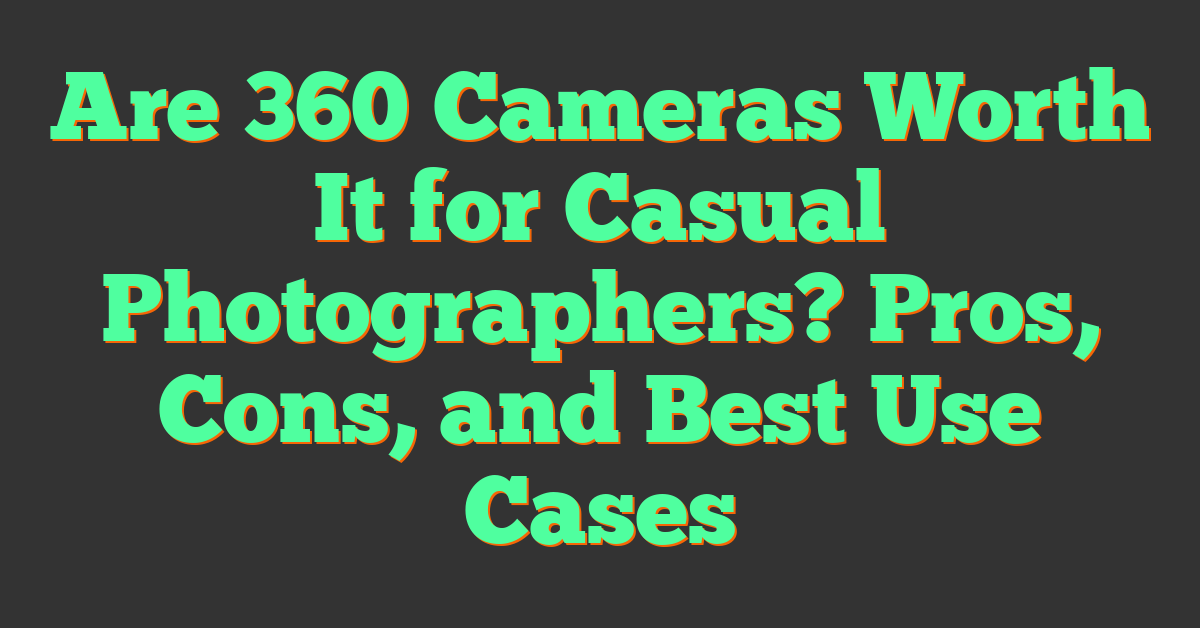Key Takeaways
- 360 cameras offer immersive and versatile photography options, perfect for capturing spherical images and videos that traditional cameras can’t replicate.
- Unique features like dual-lens designs, high resolutions, and advanced stabilization provide creative opportunities for travel, social media content, and event photography.
- Editing tools and post-capture flexibility allow casual photographers to reframe shots or apply artistic effects, enhancing the value of 360 footage for sharing or storytelling.
- Challenges include a learning curve for editing and camera usage, as well as additional costs for accessories and software, which may deter beginners or casual users.
- Alternatives like smartphone attachments or traditional cameras might be cheaper and simpler options for those who prioritize cost or ease of use over immersive capabilities.
- 360 cameras shine in niche scenarios such as travel, events, or social media content, making them a worthwhile investment for some, but not an essential tool for all casual photographers.
I’ve always been intrigued by how 360 cameras can capture everything around you in one shot. They promise immersive photos and videos that traditional cameras just can’t match. But for someone who’s not a professional photographer, are they really worth the investment?
If you’re a casual photographer like me, you’re probably wondering if these gadgets are more of a novelty or a game-changer. From their unique features to their practical limitations, there’s a lot to consider before diving in. Let’s break it down and see if 360 cameras are truly a must-have or just another tech trend.
What Are 360 Cameras?
360 cameras capture full spherical images and videos, providing an immersive viewing experience. They are equipped with specialized lenses to record everything around the camera in all directions simultaneously.
Overview of 360 Photography
360 photography allows users to create interactive media where viewers can explore scenes by panning, tilting, or zooming. Unlike traditional photos, which capture a fixed frame, 360 photos encompass the entire environment. This format is widely used in virtual reality, real estate tours, and creative content. For instance, while a standard camera frames a single perspective of a sunset, a 360 camera immerses viewers in the entire landscape, including the sky and surroundings.
Key Features of 360 Cameras
- Dual or Multi-Lens Design
Most 360 cameras have two or more ultra-wide-angle lenses, each capturing up to 190°. Software then stitches these images or videos into a seamless spherical format.
- High-Resolution Outputs
Many cameras support 4K to 8K resolutions, resulting in clear and detailed spherical visuals. For example, models like the Insta360 X3 or Ricoh Theta X deliver sharp, vibrant imagery.
- Compact and Portable
360 cameras are generally compact, often fitting in a pocket. Devices like the GoPro MAX weigh under 200g, making them ideal for travel or everyday use.
Advanced stabilization ensures smooth footage, even during motion-heavy activities like biking or skiing.
- Live Streaming and VR Integration
Some models, such as the Insta360 Pro 2, offer live 360 streaming and VR compatibility, enabling real-time audience interactivity.
- Editing Capabilities
Dedicated apps provide easy post-capture editing, including reframing options for standard photos or videos extracted from 360 footage.
Benefits of 360 Cameras for Casual Photographers
« 360 Cameras vs. Panoramic Photos: What’s the Difference and Which Should You Choose?
The History of 360 Cameras: From Revolutionary Beginnings to Modern Masterpieces »
360 cameras offer unique advantages that cater to photographers seeking immersive and versatile ways to capture memories. Their innovative features unlock creative potential and provide a new perspective on everyday photography.
Enhanced Immersion and Creativity
Immersive images and videos stand out as the defining appeal of 360 cameras. They capture complete spherical views, allowing viewers to explore scenes dynamically. This transforms simple moments into engaging, interactive experiences that feel more lifelike. Whether documenting a family gathering or exploring cityscapes, 360 cameras enable creative storytelling far beyond standard photos.
Specialized editing tools let me reframe shots and highlight captivating details post-capture. Features like tiny planet effects, hyperlapse, or panoramic sweeps push artistic boundaries and inspire experimentation. I find these creative options especially rewarding for sharing content on platforms like Instagram or YouTube, where eye-catching visuals resonate most.
Ability to Capture Every Angle
360 cameras eliminate the need to frame shots meticulously by capturing everything around their multi-lens setups. This ability ensures nothing is missed, even in fast-paced or unpredictable settings. With just one click, I document every angle of group celebrations, landscapes, or sporting events, reducing the stress of composing traditional photos.
Their versatility also supports multi-purpose use by extracting standard stills or flat-frame videos from 360 footage. This flexibility saves time and makes the cameras ideal for users who want both immersive media and conventional outputs. As someone who enjoys efficiency and quality, this dual-functionality has streamlined my photography workflow significantly.
Potential Downsides of 360 Cameras
360 cameras offer unique features, but they come with limitations that might impact their appeal for casual photographers. Understanding these challenges can help users make more informed decisions.
Learning Curve and Complexity
Using 360 cameras requires familiarity with unique techniques and tools. Unlike traditional cameras, 360 devices need specialized skills for framing, stitching, and editing. For instance, managing seamless stitching between images or efficiently navigating editing apps often demands more time and effort, especially for new users. Capturing immersive shots also means understanding optimal camera placement to avoid distortion or unwanted blind spots.
Editing software, though highly capable, can overwhelm users unfamiliar with 360 workflows. Features like keyframe animations or reframing add creative possibilities but may seem complex for beginners. These challenges potentially diminish the convenience casual photographers seek.
Price vs. Value for Casual Use
Cost can be a significant factor for casual users considering investments in 360 cameras. Entry-level models range from $200 to $400, while advanced options with 5.7K or 8K resolution, like the Insta360 X3 or GoPro Max, extend to $500 or more. At these prices, casual users may question their value compared to traditional cameras or smartphones offering high-quality photos and videos.
The necessity of additional gear—such as sturdy tripods, memory cards with higher write speeds, and editing software subscriptions—further increases expenses. For users primarily sharing content on social media, standard devices might already fulfill their basic needs, making the extra cost less justifiable.
Best Scenarios for Using 360 Cameras Casually
Certain scenarios showcase the strengths of 360 cameras, offering immersive results unmatched by traditional cameras. Below, I’ll highlight how 360 cameras excel in casual settings.
Travel and Vacation Photography
Capturing stunning landscapes and immersive scenes becomes effortless with 360 cameras. These devices allow me to document every angle of an epic sunset, bustling market, or serene mountain range. For example, during hikes, I’ve used compact 360 cameras like the Insta360 ONE X2 to capture treetop views and rugged trails simultaneously. The ability to reframe shots later eliminates the stress of perfect on-the-spot composition. For travelers wanting to revisit destinations as if they’re back there, 360 imagery transforms vacations into lasting interactive memories.
Social Media Content Creation
For dynamic and shareable posts, 360 cameras create standout content. Platforms like Instagram, Facebook, and YouTube support interactive 360 formats, letting viewers explore my surroundings by rotating their screens. I’ve edited eye-catching clips using features like tiny planet effects and hyperlapses, which catch attention and boost engagement. Whether I’m showcasing a street festival or creating creative transitions for short-form videos, 360 footage adds a fresh, immersive dimension perfect for modern social feeds.
Events and Gatherings
Capturing the atmosphere of events is seamless with 360 cameras. At birthday parties, weddings, or casual meetups, these cameras record the entire environment, preserving candid moments without missing anything. With some models offering livestream capabilities, I’ve shared events in real time with friends who couldn’t attend. The ability to crop traditional photos or videos from 360 footage ensures I can focus on hosting or enjoying the moment while still achieving polished results later. For shared memories that fully reflect the occasion, 360 cameras are indispensable.
Alternatives to 360 Cameras
While 360 cameras offer immersive and creative capabilities, there are other options that might suit casual photographers better in terms of cost, usability, or versatility. Below, I explore two popular alternatives.
Traditional DSLR or Mirrorless Cameras
DSLR and mirrorless cameras remain a top choice for photographers who prioritize high-quality images and advanced control settings. These cameras enable users to interchange lenses, offering creative flexibility for capturing everything from wide-angle landscapes to detailed portraits. Unlike 360 cameras, DSLRs and mirrorless models excel in low-light photography due to their larger sensors and superior ISO performance.
Another key advantage lies in their compatibility with numerous editing tools and software. With RAW file formats, photographers gain greater freedom to enhance colors, exposure, and details during post-processing. However, these cameras lack spherical video capability and may require meticulous framing to achieve compelling shots. For casual photographers, they’re ideal if capturing standard photos and videos is the main goal.
Smartphone 360 Camera Attachments
For budget-conscious users seeking 360-degree capabilities, smartphone attachments offer a practical solution. These compact devices connect directly to a phone’s charging port and use dedicated apps for capturing and editing spherical content. Brands like Insta360, for instance, provide lightweight modules capable of capturing 5.7K video and stitching content seamlessly via AI-driven software.
Such setups are beginner-friendly and eliminate the need for carrying a standalone 360 camera. While image resolution typically doesn’t reach the levels of premium standalone 360 cameras, they still deliver solid results for social media or virtual tours. This option appeals most to photographers who want portable, easy-to-use tools for immersive content creation without committing to a higher-priced device.
Conclusion
Deciding whether a 360 camera is worth it ultimately depends on your photography goals and how much value you place on immersive content. While these cameras offer unique features and creative possibilities, they may not be essential for everyone, especially with their cost and learning curve.
If you’re drawn to capturing dynamic, interactive memories or experimenting with new storytelling formats, a 360 camera can be a fantastic tool. However, for casual use, alternatives like smartphone attachments or traditional cameras might be more practical and budget-friendly.
Weighing the pros and cons carefully will help you determine if investing in a 360 camera aligns with your needs as a casual photographer.















